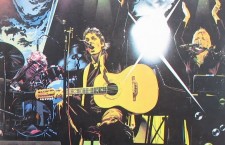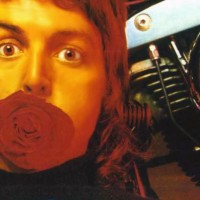It’s time to go back and reevaluate Paul McCartney and Wings’ flawed but nevertheless exciting, and always unjustly ignored Back to the Egg.
Released on June 8, 1979, the album showcased a rebuilt Wings lineup, with lead guitarist Laurence Juber working in sharp counterpoint to Denny Laine. Also on board was co-producer Chris Thomas, a former assistant to George Martin for the Beatles’ White Album who brought an edgier style to much of the project — in keeping with his concurrent work with the Sex Pistols and the Pretenders.
Paul McCartney’s stated goal, back then, was to make a raw-boned rock record. And he largely succeeded, putting a bright charge into his sound after the soft-rock fluff of 1978’s London Town. Yet, Back to the Egg wasn’t the hit that McCartney’s new label bosses at Columbia had hoped, having “only” gone platinum in the U.S. The album ended up as a million-selling yet somehow overlooked swansong for Wings.
Fast forward more than 35 years, and retro-passion surrounds Paul McCartney projects from the same era, powered in no small way by the former Beatle’s own lavish reissues of Band on the Run and McCartney II. Yet, and we have no idea just why, Back to the Egg remains comparably obscure.
That started us on a track-by-track conversation around the Something Else! Towers watercooler …
S. VICTOR AARON: Back to the Egg was a vast improvement over 1978’s London Town, but kept intact the Wings hallmarks of Beatlesque hook-filled songcraft and above average harmonies from Denny and Linda. While it might not be Wings’ best, it suggested the way forward into the 1980s. Instead, Paul shut down the enterprise in the wake of Lennon’s assassination, the infamous Japan pot bust and a desire to get off the road and raise his kids at home. That made Egg an idiosyncratic, unintended coda for one of the most successful rock bands of the 1970s.
NICK DeRISO: Unfortunately, Paul McCartney tries, in some respects, to have it both ways. Back to the Egg was simultaneously a bold move into the then-current sounds of punk and new wave but also, on its second side, a bit of a retrenchment into some of his more recognizable indulgences — including song medleys, silly love songs, even mid-century parlor pop. (“Baby’s Request” would eventually find its way, far more appropriately, onto McCartney’s 2012 standards album Kisses on the Bottom.) The album starts a lot better than it finishes.
BEVERLY PATERSON: Not only is Back to the Egg my favorite Paul McCartney and Wings album, but it also gets a gold trophy for being one of my favorite albums altogether. And the reason why rests in the simple and plain fact that every song here is so utterly catchy. These are the kind of tunes that stick hard and fast in your mind after a single listen, and there’s nothing wrong with that. Especially when the music is conceived by somebody as insanely talented as Sir Paul, and the band accompanying him.
NICK DeRISO: A Pink Floydian intro, perhaps appropriate with the addition of David Gilmour on a couple of the album’s subsequent tracks.
S. VICTOR AARON: It’s a shame this is just a brief intro; “Reception” grooves as good as Wings ever did.
Released June 1979 in the U.S.; No. 20 on Billboard charts
S. VICTOR AARON: So squarely aimed for the radio, it even begins with a radio tuning into the song. But it sets the tone for the album: two guitar attack up front, keyboards set way back, and earworm characteristics. But “my salamander”? Must be a temporary lyric left in, a la “the movement you need is on your shoulder.”
NICK DeRISO: Salamander. One of the great throwaway non sequiturs from McCartney. A slimy, amphibian wall crawler? On what planet is this a term of endearment? Later, Paul, in a moment of sweeping pop-song myopia, pleas for the DJ to “play a song with a point.” Yet, I still find “Getting Closer” to be, at least at first, one of the most propulsively enjoyable tunes on Back to the Egg — thanks, in no small way, to Juber’s monstrous riff. Of course, Paul McCartney can’t leave it at that. Before it’s over, he returns to a confusing, now career-long habit of toss-off solo finales – inexplicably abandoning the song’s tightly packed construct after a couple of minutes for a swirling, rather confusing fade out.
[SOMETHING ELSE! INTERVIEW: Former Wings lead guitarist Laurence Juber talks about graduating from “McCartney University” – and then transitioning into his ongoing role as a solo guitar virtuoso.]
NICK DeRISO: Wouldn’t this have made a better album-opening track? Though it’s a little staid, at least it sets a theme of late-night abandon. Sort of. Is that a glockenspiel?
BEVERLY PATERSON: From the jaunty motions of “We’re Open Tonight” to the polished new wave poise of “To You” to the power popping drive of “Getting Closer” to the frenzied punk rock instructed impulses of “Spin It On,” the record portrays the strengths and assets of Paul McCartney and Wings time and time again. The songwriting is solid throughout, with hooks and melodies hammered in all the proper places, the arrangements are smartly organized and the playing is tight and enthused. Paul’s vocals, which have always been the epitome of ear candy, are as lucid and fluid as they have ever been, and the harmonies sparkle and soar in a most majestic way.
Released as the American B-side to ‘Getting Closer’
NICK DeRISO: One of the clearest examples of what, I think, this album was supposed to do: Show that Paul McCartney could plug into the zeitgeist as punk and new wave were building into genre-shifting forces. For all of his notable successes as a schlock and roller, Paul is always — going all the way back to the mop top days — good for a throat-shredding, don’t-give-a-shit moment or two. Here’s one.
S. VICTOR AARON: This hyperkinetic track suggests an influence of punk, but really it’s more rooted in his Mersey Beat days, only sped up. This is how the old rockers do it.
NICK DeRISO: A terrific showcase for the criminally underutilized Denny Laine, who might not have been John Lennon but certainly could have contributed more than the off-handed backup vocal, given the opportunity. Instead, there are only these drive-by glimpses into what a true partnership in the band could have been.
S. VICTOR AARON: Who let Delbert McClinton into the studio? Not that I’m complaining.
Released June 1979 in the UK; a No. 35 hit
S. VICTOR AARON: One of the hardest-rocking sounds on the albums, and would have been a hit in a different time. A Laine-Juber riff so good, it became a kind of wordless chorus for the song.
NICK DeRISO: It took one of the Wings era’s grittiest, most unromantic riffs to overcome what emerges as a borderline racist keyboard signature. Though it sometimes feels like the kind of song you listen to with the blinds pulled, I usually find myself — and I always have — completely absorbed in this track’s clattering attitude.
Released August 1979 in the U.S.; a No. 29 hit
S. VICTOR AARON: More of a Paul McCartney tune instead of a Wings one, this blue-eyed soul slow groover combines Aja-era Steely Dan with The Stranger-era Billy Joel in the best possible way. Impeccably produced with a gurgling Wurlitzer, a metronomic beat briefly left alone after each chorus and a deftly deployed horn arrangement, Macca’s voice easily glides in and out of falsetto in his underappreciated crooner mode. It stands apart from the rest of the album, but it’s also McCartney when he’s on his A-game in the songcraft department. And when he’s on, it’s as good as it gets anywhere.
NICK DeRISO: Easily the best cut on Back to the Egg, even allowing for the use of somewhat-dated synthesizer. Just what’s happened to the protagonist is largely indecipherable, but superfluous anyway. Not when this track, after the addition of an itchy late-song brass signature, bursts out with a girder-shaking groove.
[SOMETHING ELSE! INTERVIEW: Ace sessions drummer Denny Seiwell, a founding member of Wings, talks frankly about joining Paul McCartney’s band: ‘Play with one Beatle, and it really fucks up your jazz career.’]
Winner of the first-ever Grammy for rock instrumental performance
BEVERLY PATERSON: Sure-footed pop rock aimed right at the radio dial is what Back to the Egg entails, with the exception of “Rockestra Theme,” a rather left-field entry which rates as another gleaming diamond featured on the record. An amazing cast of top drawer musicians join Paul and the band on the instrumental number, such as Pete Townshend, David Gilmour, John Paul Jones, Hank Marvin, John Bonham and Gary Brooker. Caked with chugging rhythms, “Rockestra Theme” jams on and on to a loud and loose symphony comprised of sweaty guitars, thundering drums, stabbing keyboard drills and honking horns, resulting in quite a heavy piece of music.
S. VICTOR AARON: It’s big, bombastic rock, like an improved version of “Rock and Roll Parts 1 and 2.” Not fancy, but Paul McCartney always thought that if you’re going to rock out, you might as well have fun doing it.
NICK DeRISO: Despite its all-star cast of sidemen, this somehow starts out as a largely pedestrian piffle, like listening to a group of classically trained orchestra members try to, you know, rock out. Until everything breaks down, and the rabble cries out: “I have not had any dinner!” I don’t know why, but I’ll listen to this song — every time — just for that.
NICK DeRISO: A song for those who wondered what Paul would sound like if he were broadsided by the Cars. First off, McCartney hiccups, no kidding, like Ric Ocasek. And it’s not just the vocal. Check out the careening keyboards, Steve Holly’s clipped rhythm, Juber’s sawing guitar. It doesn’t sound much like Wings. But it sounds a whole lot like what would one day dominate the playlists of some as-yet-unknown network called MTV. Play this song a few times before you move on, though. The creative phase of Back to the Egg has ended, my salamander.
S. VICTOR: It didn’t occur to me at the time the record first came out, but this does come off more like a Cars demo than a Wings song. Hearing Paul get gritty like that is alright by me, especially when accompanied by that sinister slide guitar.
S. VICTOR AARON: Just when I think, boy, he can’t miss …
NICK DeRISO: Of course, he has to go and screw it up. Moments after embracing something so brilliantly modern, Back to the Egg swerves into a melancholy power ballad, which then somehow morphs into an accordion-driven lament called “Million Miles.” I’ll repeat, in its entirety, my comment upon getting to this point in the album for the very first time: What. The. Hell?
NICK DeRISO: Starts out treacly, even morose, then takes a half step up into boring and sophomoric. Didn’t we say we like this album?
S. VICTOR AARON: I thought Wings had left this pap crap behind on London Town.
[SOMETHING ELSE! INTERVIEW: ‘Red Rose’-era Wings guitarist Henry McCullough talked about his time with Paul McCartney and Joe Cocker, and how addiction almost cost him everything.]
NICK DeRISO: Another throwaway snippet of Pink Floyd-inspired dialogue. The cool thing about CDs, when they finally came out, was that you never had to listen to filler like this again.
S. VICTOR AARON: The Major Piece of Work track of the album. Representing the three most important British rock bands after the Beatles and the Rolling Stones, you have David Gilmour, Pete Townsend and John Bonham as part of an orchestra that Paul uses not to make some intricately-arranged prog piece, but to simply make the sound huge. The cacophony winds down at the end for overlapping vocals by Paul, Linda and Denny that brings the huge musical zeppelin down to a soft landing.
NICK DeRISO: It’s true. There is some small amount of joy in finally — finally — hearing a song that isn’t either boringly retrograde or just plain snoozy. But only, like I said, a small amount. Unfortunately, there’s nothing Laurence Juber and Co. can do to keep this from ending up as a rocker in the vacuum-packaged style of Wings at the Speed of Sound. Linda sings like someone battling through an Ambien hangover. Denny Laine sounds like he’s already one foot out the door. And it has all of the visceral danger of, well, a salamander. Still, following the whole “After The Ball”-to-“The Broadcast” debacle, this tune has an almost “Jet”-like propulsion, and allows Back to the Egg — and Wings, we would soon learn — to end on a decidedly upbeat, if unfathomably safe, note. Oh, wait: There’s more.
B-side to the UK single release of ‘Getting Closer’
S. VICTOR AARON: Totally out of place on this record but right at home, of course, on the much-later Kisses On The Bottom. Taken on its own merits, Paul McCartney’s done much worse when he’s done songs in the style of his parents’ music, but the synth replacing a trombone during the instrumental break is unforgivable. C’mon, son!
NICK DeRISO: What. The. Hell?, Part Deux. This prosaic swing-band pastiche — remember “Honey Pie” from The White Album, “You Gave Me The Answer” from Venus and Mars, so on? — just didn’t sound that charmingly retro anymore by 1979. What it sounded was hopelessly, devastatingly old-timey, the opposite (I guess, right?) of what this album was trying to do. Right?
BEVERLY PATERSON: It’s too bad Back to the Egg marked the end of Paul McCartney and Wings. Awash with keen ideas, vital energy and songs that clicked, it appeared as if there was a sense of rejuvenation going on. But it was not to be, and Paul quickly resumed the solo career he embarked on following the demise of the Beatles. I realize it’s not fair to constantly compare Paul’s post-Beatles efforts to the brilliant work of the Beatles, but I will say there’s at least a trio of tunes on Back to the Egg that are just as cool as the stuff he did with his old band.
- Ernesto Cervini’s Turboprop, “When I Fall” (2024): Video premiere - March 15, 2024
- Disaster Pony,“Dead Neon & The Noon Sun” from ‘Disaster Pony’ (2024): Video premiere - February 27, 2024
- Christopher Hoffman, “Farewell Forever” from ‘Vision Is The Identity’ (2024): Streaming premiere - February 19, 2024




